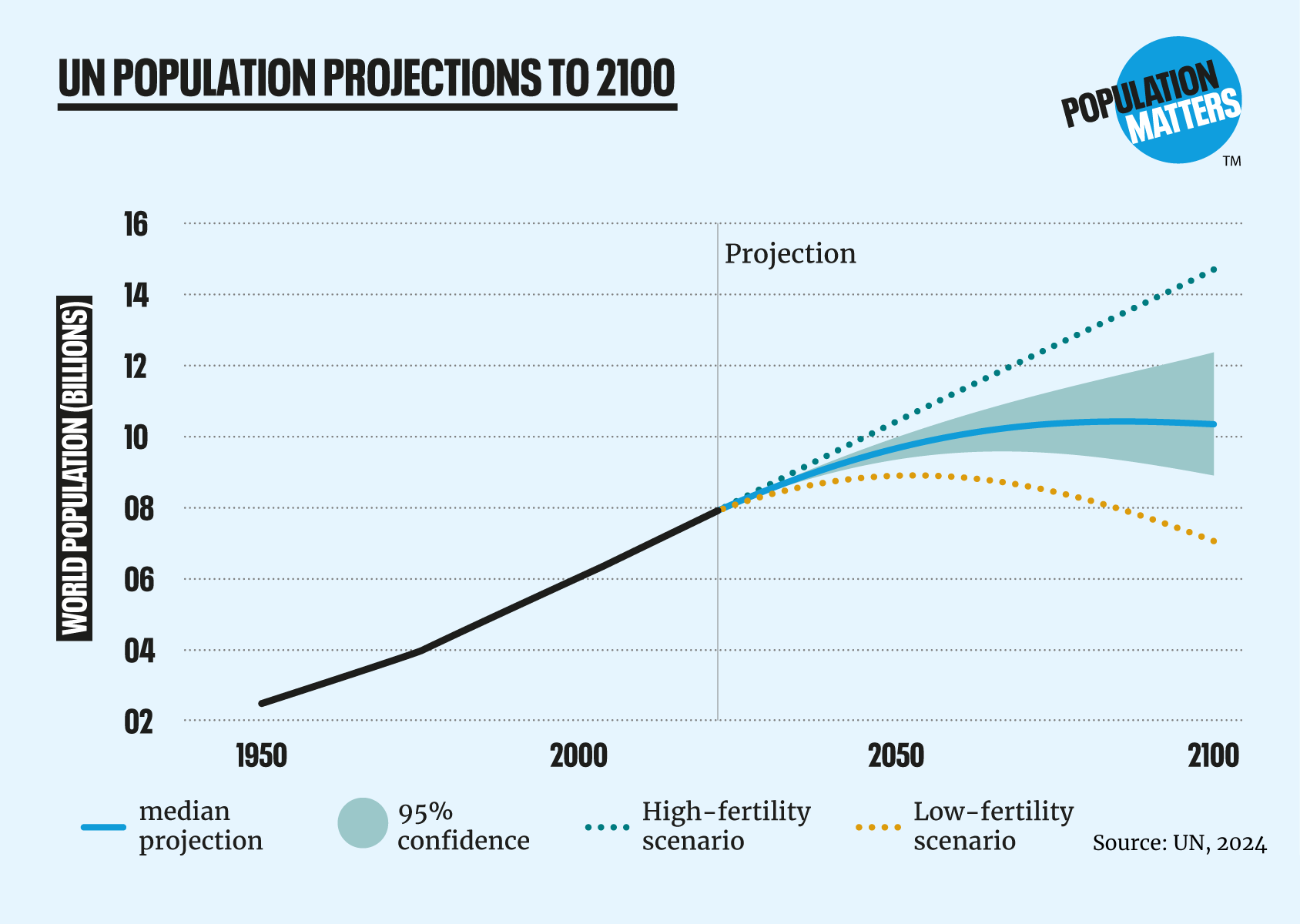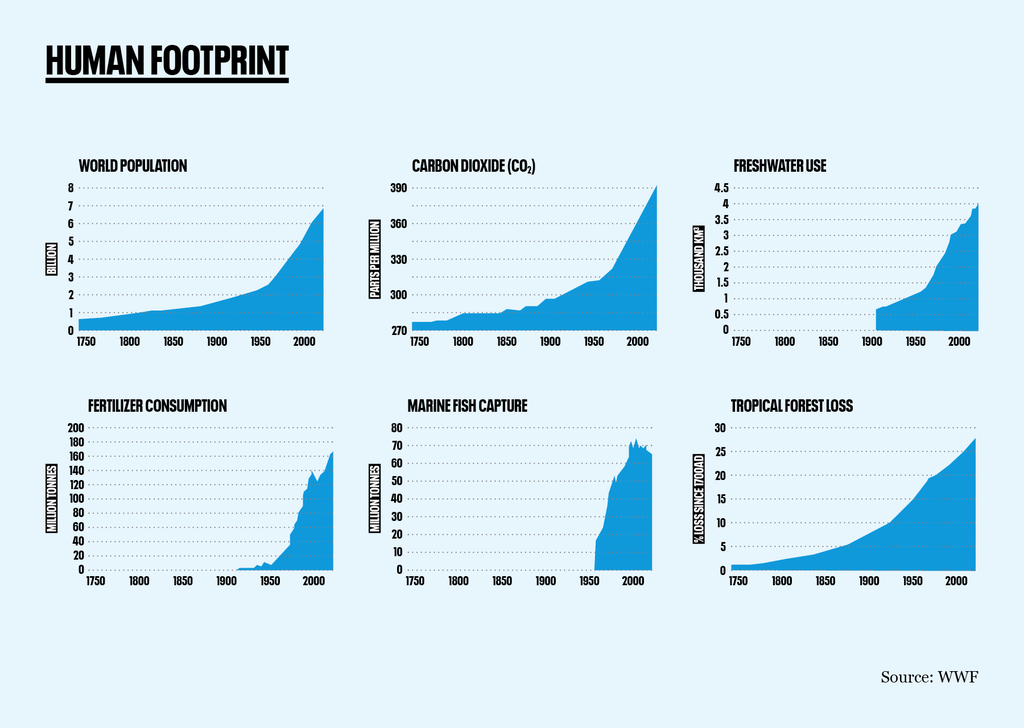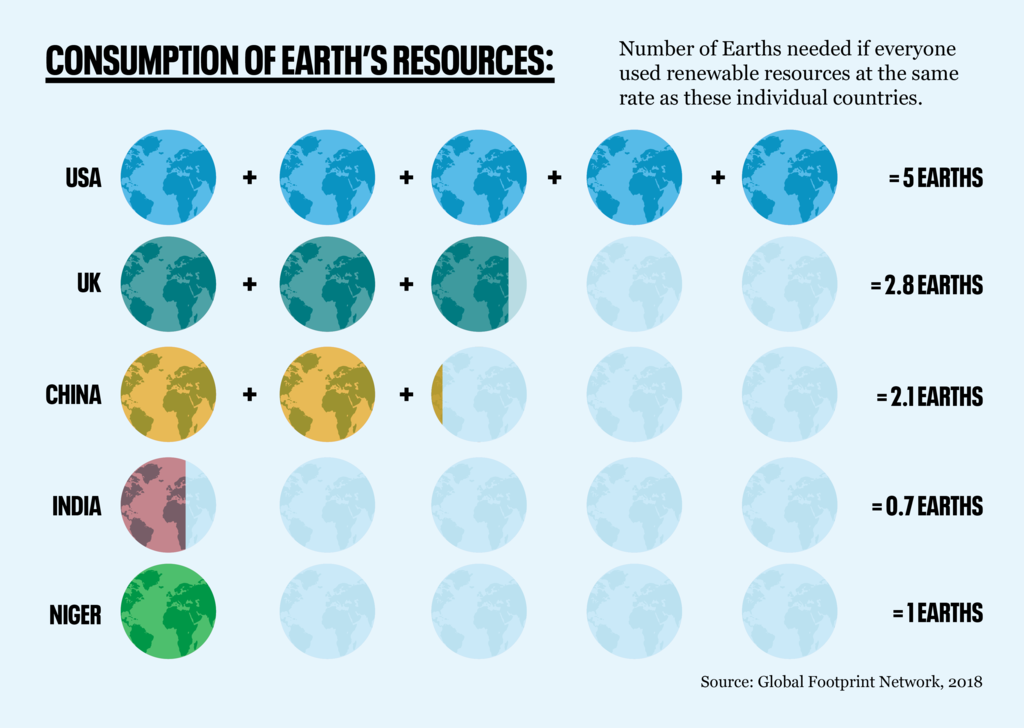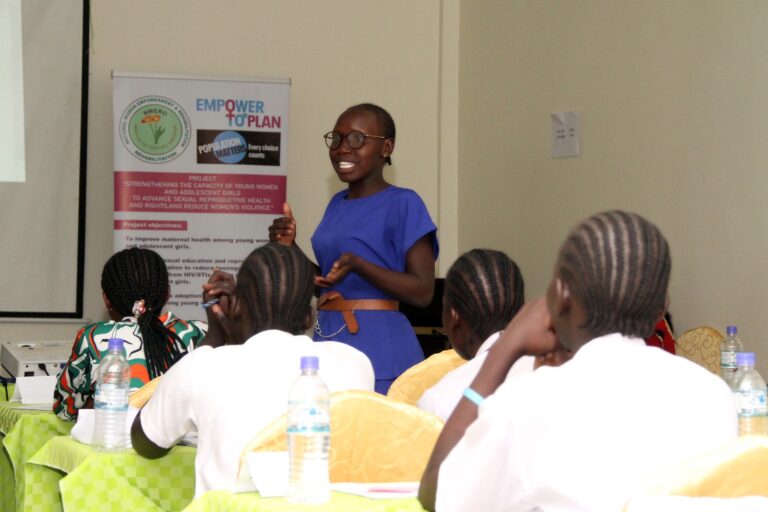
Mythbusting
There are many misconceptions about population – what the numbers say, what the impact is, and what population campaigners want to do about it.
Below are some of the most common population myths that we encounter.
“POPULATION IS GOING TO STOP GROWING SOON ANYWAY”
It just isn’t. Unless we do something about it. The UN’s median projection for future population growth sees us hitting 10.3 billion about 60 years from now. We can bring about the end of growth sooner and achieve a more sustainable population size – but only if we take the action to promote positive, empowering population solutions, now.
Some believe our population has already stopped growing because of misleading media headlines about declining birth rates. The rate of population growth and average family size have been shrinking, but the total number of people added to the planet every year has been increasing until recently. For example, in 1950, the world population was 2.5 billion and growing at 1.9% per year, resulting in an absolute increase of around 47 million people. Today, the growth rate is less than 1% per year, but because our total population is more than three times larger, the absolute annual increase is more than 60 million people per year.

It is true that some other projections of future population growth are lower than those made by the UN, but none see population peaking before 2050, or fewer people in 2100 than there were in 2000. The UN projections have a strong track record of being proven correct.
“HAVING A SMALLER FAMILY WON’T MAKE ANY DIFFERENCE”
Choosing to have smaller families (one, two or even no children) is exactly how we end population growth and ultimately achieve a sustainable population on the planet.
The graph above also shows just how much difference a small change can make over the long term. The UN calculates that if, on average, every other family had just one fewer child than predicted (‘half a child’ less per family), there would be 1 billion fewer people by 2050 than currently projected, and our population would be lower in 2100 than it is today.
“FOCUSING ON POPULATION IS A DISTRACTION FROM BIGGER ISSUES LIKE CLIMATE CHANGE”
Environmental crises like the sixth mass extinction and climate change demand urgent action. Addressing population is a key part of the solution to those and multiple other environmental problems. The choice is not between addressing population and taking other forms of action – we must do both.
In 2017, thousands of scientists from more than 180 countries signed a call for action detailing the gravity and urgency of the environmental threats of our time. Speaking of “widespread misery and catastrophic biodiversity loss” unless humanity urgently changes its ways, their Warning to Humanity says:
We are jeopardizing our future by not reining in our intense but geographically and demographically uneven material consumption and by not perceiving continued rapid population growth as a primary driver behind many ecological and even societal threats.”
Now signed by more than 20,000 scientists, the Warning to Humanity calls for governments to take action to reduce fertility rates and for nations and governments to support the goal of a sustainable human population.

“THIS IS ABOUT GLOBAL INJUSTICE. THERE’S PLENTY TO GO AROUND IF WE ALL TAKE OUR FAIR SHARE”
The gross inequalities that exist between nations and sometimes within nations are an outrage that must be addressed. Many of us consume far more of the Earth’s resources, and contribute far more to environmental problems like climate change, than billions of poorer people in the world. In a world in which hundreds of millions have too little to eat and nearly two billion are obese, the distribution of resources is clearly a grave injustice.
But redistribution without ending population growth will not result in sustainability. The Earth simply cannot indefinitely provide enough to go around.
At the most basic level, everyone needs food and water. The Food and Agriculture Organization estimates we will need 70% more food by 2050 but climate change is making agricultural land unproductive. The Massachusetts Institute of Technology has calculated that by 2050, 5 billion people will live in “water-stressed” regions – meaning that they cannot rely on their water supplies to meet their needs.
Of course, people need and use far more than food and water. The International Research Panel projects that we will need 70% more resources by 2050. This is mainly because hundreds of millions of people are escaping poverty (clearly a good thing), with their consumption of resources rising accordingly. However, these rising demands are often in places with high birth rates, creating a perfect storm of resource use.
A more equitable and just global system is urgently needed. There must be a convergence in living standards, where the rich take far less and the poor have far more. While we continue to add people and their inevitable demands for resources to the population, however, we are putting pressure on the Earth that it cannot sustain.
“ENVIRONMENTAL DAMAGE IS ABOUT CONSUMPTION, NOT POPULATION”
It’s about both. While it is clear that we need to change our consumption habits, adding more consumers only exacerbates every problem arising from it. The reality is that hundreds of millions of people have an absolute right to consume more, as they move out of poverty.
Those of us in the rich world especially need to live more sustainably as societies and as individuals. Stopping more consumers being added to the global population is another, and vital, way of reducing our overall consumption.
In the 1970s, our patron Paul Ehrlich and his colleague John Holdren proposed an equation to represent the factors which impact the environment:
I = P x A x T
“I” is impact, “P” is population, “A” is affluence and “T” is technology. The “IPAT” equation shows that our numbers, how we live, and the technology we use all have an effect. We must not set up a false opposition between consumption and population. Both must be addressed.

“DON’T WE NEED YOUNG PEOPLE TO SUPPORT AN AGEING POPULATION?”
This isn’t the case. Those young people will also become old. The idea that we need more people to support older generations is an unsustainable pyramid scheme – benefiting the present generation at the expense of the next.
Instead, we need to grasp the opportunities presented by an ageing population, including less unemployment, a stimulus to greater productivity – especially exploiting new technology – and the availability of fit, talented retired people to contribute to our communities. We must address the challenges creatively and positively, and if we truly value our older people, that includes investing more resources in their wellbeing. Recent reports have highlighted the opportunities available and how important it is to reframe the debate about ageing.
The alternative to a creative and positive approach to ageing is constantly increasing our population in a vain attempt to catch up. That means continued climate change, continued biodiversity loss and continued depletion of the Earth’s resources. We can provide better support for the elderly if we choose. We cannot bring back melted glaciers or species which have gone extinct.
“YOU CAN’T REDUCE THE POPULATION WITHOUT COERCION OR ABUSING HUMAN RIGHTS”
You can. Coercive measures, like China’s one-child policy, are not needed and abuse people’s human rights. Time and time again, fertility rates have been brought down quickly and substantially in many parts of the world through ethical, positive measures. To address our current environmental crisis and achieve a global population that the Earth can sustain and a decent quality of life, we have to do more, better and quicker than we’ve ever done before. That goal is achievable.
The recipe is proven and simple, and improves people’s lives in multiple other ways:
- Empower women
- Provide good education for all
- Remove barriers to high-quality, modern family planning
- Tackle poverty
- Improve child and maternal health
- Challenge harmful beliefs that oppress women and lead to large families, and encourage smaller families.
“POPULATION CONCERN IS INHERENTLY RACIST/ECOFASCIST”
The areas with the highest birth rates are in the Global South, which leads some people to believe that population concern is about shifting the blame for our environmental crises onto those least responsible. This is simply not the case. Population Matters, of course, abhors all forms of racism and fascism, and we are committed to fighting inequalities.
While the climate crisis is not the only environmental issue, modern population campaigners fully recognise that the Global North is responsible for the vast majority of historical emissions, which is why we call for reduced consumption and smaller families in wealthy countries. However, population growth has a huge negative impact on the environment, especially on biodiversity, and sweeping the issue under the rug means neglecting urgently needed, empowering solutions. For example, half of all women in low- and mid-income countries still have no bodily autonomy and the number of women with an unmet need for modern contraception is still increasing due to population growth outstripping family planning development aid.
Women’s empowerment is grossly underfunded and urgently needs to be leveraged across all sectors, including the environmental movement. Ignoring the population factor because of unjustified myths and misconceptions hurts everyone, especially the most vulnerable communities that are heading towards disaster due to the combination of environmental degradation and rapid population growth, such as the Sahel region of Africa.
“BIRTH RATES ARE LOW IN EUROPE AND AMERICA – THIS IS JUST AN ISSUE FOR OTHER PARTS OF THE WORLD”
People in the developed world, such as Europe and America, have a disproportionate impact on the planet. That means that fewer people being born in wealthy countries has the most immediate and positive impact on our environment, climate and sustainability.

“TECHNOLOGICAL INNOVATION WILL SAVE US”
Many assume that technological progress will allow us to feed the world sustainably, fix climate change and stop depleting natural resources, despite our increasing numbers. However, even technology does not enable limitless growth on a finite planet.
When Norman Borlaug was awarded the Nobel Peace Price in 1970 for his pioneering work to increase crop yields, he highlighted the impermanence of technological fixes under population growth:
The green revolution has won a temporary success in man’s war against hunger and deprivation; it has given man a breathing space. If fully implemented, the revolution can provide sufficient food for sustenance during the next three decades. But the frightening power of human reproduction must also be curbed; otherwise the success of the green revolution will be ephemeral only.“
A 2017 study by the Massachusetts Institute of Technology found that no matter how much more efficient and compact a product is made, demand for that product will continue to grow (due to better performance and reduced cost), leading to increased material use and resource extraction. The researchers looked at 57 common goods and services, including polyester fibre, laser diodes and crude oil, and found that despite technological improvements in almost all cases, there was not a single case of ‘dematerialisation’ (an overall reduction in materials).
Technological innovation has led to important environmental progress, such as harnessing renewable energy, but it has also hastened environmental destruction, for example by enabling the extraction and burning of fossil fuels on a massive scale.
Technology might solve our problems, but we cannot gamble with our futures or the wellbeing of the world’s most vulnerable people when we can take action now to make things better.
“THERE’S LOTS OF SPACE LEFT ON THIS PLANET FOR MORE PEOPLE”
This argument completely ignores the fact that people aren’t Tetris blocks. Providing water, food, shelter, public services and infrastructure for everyone requires a huge amount of space. Large parts of our planet are covered in ocean, barren land and ice, which are unfit to support human life. We already occupy more than half of all habitable land on Earth, largely due to agriculture. However, millions of other species on Earth also have a right to exist. Ever more humans means ever less nature. We need to rethink our relationship with the natural world and develop more compassion towards other beings. It’s their planet too.
Population MYTHBUSTING GRAPHICS
You can download our Mythbusting graphics series here:
Top 10 population myths from Population Matters



